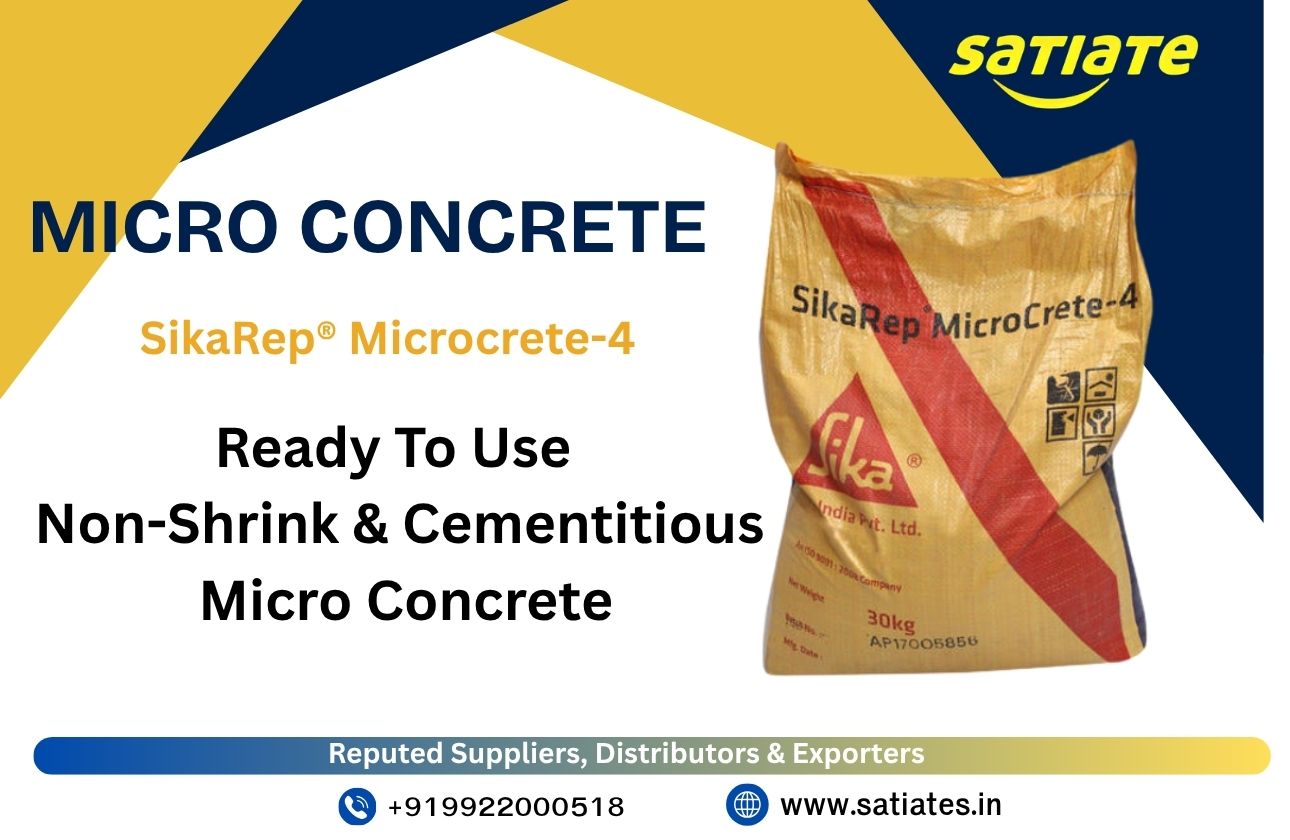Micro Concrete: The Perfect Choice for Thin Repairs & Resurfacing
Micro Concrete (also known as micro‑cementitious concrete or non‑shrink repair concrete) is a polymorphic, high performance material for repairing, resurfacing, and coating a variety of substrates. At Satiate Solutions, we offer premium micro concrete powders—ready for on‑site mixing—to provide strength, reliability, and beauty. Discover more about what micro concrete is, where and how it is used, its benefits, and how Satiate ensures you achieve superior results.
What Is Micro Concrete?
Micro Concrete is a thin cementitious coating or repair mortar applied very thinly—usually 2–3 mm thickness—over surfaces like tile, wood, or existing concrete.
It is delivered as a dry premixed powder blend which, when mixed with clean water (and in some cases coarse aggregate at the works), develops into a non‑shrink, flowable, hard wearing repair mortar. The mix typically consists of:
- High quality fine aggregates
- Cement and supplementary binders
- Shrinkage compensating additives
- Rheology modifiers and dispersants
With all ingredients pre‑proportioned in the factory mix, field variability is minimized and consistent quality is more guaranteed.
One of the renowned products in this area is SikaRep Micro Concrete, a pourable non‑shrink micro concrete, which is widely utilized for structural repairs of concrete columns, beams, slabs, and large gap grouting.
Why Use Micro Concrete?
Micro concrete, or micro cement, or non-shrink repair mortar, is quickly becoming the go-to solution for repairing, resurfacing, and rejuvenating worn-out or aging concrete structures. So why is this material so effective? Here's a closer examination of the top reasons why micro concrete is being used so extensively in today's construction and restoration:
1. Non-Shrink Properties for Long-Term Durability
One of the greatest benefits of micro concrete is its non-shrinkage quality. Conventional mortars or concrete tend to shrink when they cure, causing cracks or loss of bond. Micro Concrete, though, contains shrinkage-compensating additives that enable it to keep its form and volume when curing and even after curing.
2. Ideal for Difficult-to-Access Repairs
In most building works, the use of plain concrete is impossible—particularly in confined spaces, overhead surfaces, vertical columns, or detailed work. Micro concrete is extremely flowable, enabling it to be pumped or flowed into small gaps, formworks, or cavities without compaction or vibration.
3. High Compressive & Bonding Strength
Don't be misled by its thin profile—micro concrete is built for function. Properly mixed and applied, it will develop compressive strengths of 40 MPa and above, which qualifies it for structural work and heavy-duty usage. It also bonds well to all types of substrates ranging from old concrete, masonry, tiles, and even wood (when properly primed)
4. No Need for Vibration or Compaction
Regular concrete usually needs vibration to evacuate air holes and provide even strength. Micro concrete does not need that. Its self-leveling property guarantees it to move freely and fill gaps completely, making it ideal where equipment cannot be utilized
Why Choose Satiate Solutions for Micro Concrete?
Where high-performance micro concrete solutions are concerned, and with whom to partner in trust, Satiate Solutions is a construction chemical industry leader. We do not simply supply materials — we supply solutions, reliability, and full support from selection through application.
Applications of Micro Concrete
Micro Concrete is a flexible material which finds application in all manner of construction, repair, and restoration work. The fact that it can flow into small spaces, strongly bond with the existing substrates, and provide high compressive strength makes micro concrete suitable for diverse structural and aesthetic functions.
1. Structural Repairs
One of the significant applications of micro concrete is in repair work on distressed concrete elements such as
When cracks, honeycombs, spalling, or surface deterioration occur in concrete structures, micro concrete can restore their strength and function without having to replace them in full. Its high-bonding and non-shrink properties make it ideal for bearing loads repairs.
2. Void and Honeycomb Filling
Micro concrete is best used to fill voids, cavities, or honeycombs in structural concrete. Due to its free-flow quality, it flows into irregular or restricted spaces where regular mortar or concrete may be ineffective.
3. Repair of Overhead and Vertical Surfaces
Traditional concrete is hard to apply on vertical or overhead surfaces because of gravity and flow limitations. Micro Concrete can be applied with very little sagging and good bonding, however.
4. Floor Resurfacing and Levelling
Micro concrete is commonly employed in floor renovation work to resurface, smooth, and level old or uneven concrete floors.
How to Apply Micro Concrete: Step-by-Step Guide
Micro concrete is a superior material that provides outstanding outcomes if used appropriately. Whether one uses it for repairing structures, levelling surfaces, or decorative coats, using it correctly is the secret to gaining durability and a clean finish.
Frequently Asked Questions (FAQs)
1. What is the minimum and maximum thickness for micro concrete?
Ans: Micro concrete is typically applied in 2–3 mm thin layers, but depending on the product and mix design, it can go higher (e.g. up to 10–20 mm in some formulations). Always follow the manufacturer’s guidelines.
2. Can micro concrete be used for structural repairs?
Yes. Many Micro Concrete formulations are engineered to meet structural repair requirements, offering high compressive strength, adhesion, and non-shrink behavior suitable for repairing beams, slabs, columns, etc.
3. How long does micro concrete take to gain strength?
Ans: Initial set can occur within a few hours (depending on temperature and admixtures). Typically, micro concrete reaches significant strength in 7 days; full strength is often achieved by 28 days (or per product spec).
4. Is micro concrete waterproof?
Ans: Micro Concrete is not inherently waterproof in all cases—but many mixes include additives or supplementary sealers to improve water tightness. For critical waterproofing, combine micro concrete with waterproofing membranes or coatings.
Visit: https://www.satiates.in/micro-concrete.php
Contact: +91 9922000518
Published on October 15, 2025 by Admin
